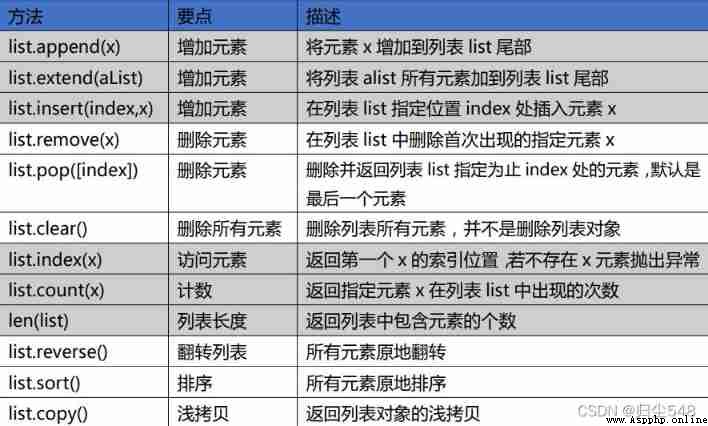Sequence is a way to store data , Used to store a series of data .
Common sequence structures are : character string ( See last time )、 list 、 Tuples 、 Dictionaries 、 aggregate
list : Used to store any number of 、 Any type of data set .
List defined criteria Grammar format : a = [10,20,30,40] among ,10,20,30,40 These are called : list a The elements of . The elements in the list can be different , It can be Any type . such as : a = [10,20,'abc',True]
The common methods of list objects are summarized as follows :

List creation :
1.[] Create a list of
>>> a = [10,20,'giao','hu']
>>> a = [] # An empty list 2.list() Create a list of
>>> a = list() # An empty list
>>> a = list(range(10))
>>> a
[0, 1, 2, 3, 4, 5, 6, 7, 8, 9]
>>> a = list("giao,hu")
>>> a
['g', 'i', 'a', 'o', ',', 'h', 'u']3.range() establish Integers list :
Format :range(start,end,step)
>>> range(3,5,1)
range(3, 5) # Create a list of
>>> list(range(3,5,1))
[3, 4] #list() Print
>>> list(range(-10,-1,3))
[-10, -7, -4]
>>> list(range(10,1,-3))
[10, 7, 4]
>>> list(range(-1,-10,-3))
[-1, -4, -7]
4. Generate list by derivation
>>> a = [x*2 for x in range(5)]
>>> a
[0, 2, 4, 6, 8]The addition of list elements :
1.append()
Modify the list object in place , Is to add a new element at the end of the real list , The fastest , Recommended .
>>> a = [20,40]
>>> a.append(60)
>>> a
[20, 40, 60]2.+
Create a new list object , Copy the elements of the original list and the elements of the new list into the new list object in turn . Slow speed , Large amount of data not recommended .
>>> a = [20,40]
>>> id(a)
46016072
>>> a = a+[50]
>>> id(a)
460154323.extend()
Add all elements of the target list to the end of this list , Do not create new list objects .
>>> a = [20,40]
>>> id(a)
46016072
>>> a.extend([50])
>>> id(a)
460160724.insert()
Any element can be inserted into any position , But it will cause the whole copy and paste displacement of the subsequent elements , Low efficiency . Similar to that :remove()、pop()、del().
>>> a = [10,20,30]
>>> a.insert(2,100)
>>> a
[10, 20, 100,30]5. Multiplication extension
Generate a new list .
>>> a = ['sxt',100]
>>> b = a*3
>>> a
['sxt', 100]
>>> b
['sxt', 100, 'sxt', 100, 'sxt', 100]List element delete :
1.del Delete
Delete the element at the specified position in the list .
>>> a = [100,200,888,300,400]
>>> del a[1]
>>> a
[100,200,300,400]2.pop() Delete
Delete and return the specified location element , If no location is specified, the last element of the default action list .
>>> a = [10,20,30,40,50]
>>> a.pop()
50
>>> a
[10, 20, 30, 40]
>>> a.pop(1)
20
>>> a
[10, 30, 40]3.remove()
Delete the first occurrence of the specified element , If the element does not exist, an exception is thrown .
>>> a = [10,20,30,40,50,20,30,20,30]
>>> a.remove(20)
>>> a
[10, 30, 40, 50, 20, 30, 20,30]List element access and counting :
1. Direct access to elements through indexes .
>>> a = [10,20,30,40,50,20,30,20,30]
>>> a[2]
302.index() visit
Gets the index position of the first occurrence of the specified element .a.index( Access elements , start , End )
>>> a = [10,20,30,40,50,20,30,20,30]
>>> a.index(20)
1
>>> a.index(20,3)
5
>>> a.index(30,5,7)
63.count() visit
Returns the number of times the specified element appears in the list .
>>> a = [10,20,30,40,50,20,30,20,30]
>>> a.count(20)
34.len() Return length
Returns the number of list elements .
>>> a = [10,20,30]
>>> len(a)
3
Membership judgment :
in and not in
>>> a = [10,20,30,40,50,20,30,20,30]
>>> 20 in a
True
>>> 100 not in a
TrueSlicing operation :
slice operation ( See last time )
Traversal of list :
>>> a=[0,1,2,3,4,5,6,7,8,9]
>>> for a in range(len(a)):
>>> print(a,end=' ')
0 1 2 3 4 5 6 7 8 9Sort the list :
1. Do not create a new sort of list :
>>> a = [20,10,30,40]
>>> a.sort() # Default ascending order
>>> a
[10, 20, 30, 40]
>>> a = [10,20,30,40]
>>> a.sort(reverse=True) # Descending order
>>> a
[40, 30, 20, 10]
>>> import random
>>> random.shuffle(a) # Out of order
>>> a
[20, 40, 30,10]2. Create a new sort of list :
>>> a = [20,10,30,40]
>>> a = sorted(a) # Default ascending order
>>> a
[10, 20, 30, 40]
>>> a = [20,10,30,40]
>>> b = sorted(a)
>>> b
[10, 20, 30, 40]
>>> c = sorted(a,reverse=True) # Descending
>>> c
[40, 30, 20, 10]3.reversed() Return iterator :
Returns an iterator object arranged in reverse order . Be careful : This object can only be used once .
>>> a = [20,10,30,40]
>>> c = reversed(a)
>>> c
<list_reverseiterator object at 0x0000000002BCCEB8>
>>> list(c)
[40, 30, 10, 20]
>>> list(c)
[]List related functions :
max(),min(),sum() wait .
2 d list :
>>> a = [
[" Gao Xiaoyi ",18,30000," Beijing "],
[" Gao Xiaoer ",19,20000," Shanghai "],
[" Gao Xiaoyi ",20,10000," Shenzhen "],
]
>>> for m in range(3):
>>> for n in range(4):
>>> print(a[m][n],end=' ')
>>> print()
Gao Xiaoyi 18 30000 Beijing
Gao Xiaoer 19 20000 Shanghai
Gao Xiaoyi 20 10000 Shenzhen
 If you dont understand, just ask how Python connects to MySQL. Please be more specific
If you dont understand, just ask how Python connects to MySQL. Please be more specific
`#!/usr/bin/python-- coding: U
 Python calculates the area and perimeter of a circle. Analysis of the real problem of level 2 of the python programming level examination of the Electronic Society for youth programming march2021
Python calculates the area and perimeter of a circle. Analysis of the real problem of level 2 of the python programming level examination of the Electronic Society for youth programming march2021
Catalog python Calculate the a